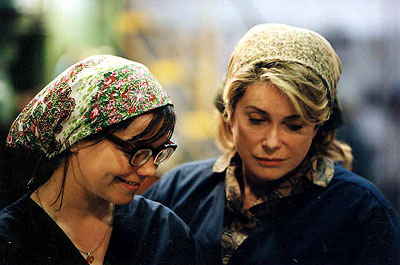

Lars von Trier's Dancer in the Dark is easily one of the most polarizing movies of recent memory. People leave the theater either loving it or detesting it. It won the Palme D'Or at the Cannes Film Festival and garnered a Best Actress Award for Bjork. Dancer in the Dark also received lots of advance press on the alleged infighting between von Trier and Bjork over direction. Von Trier is famous for being the mastermind behind the Dogma 95 movement, a dedication to artistic integrity in filmmaking. In his past films Secrets and Lies and The Idiots, he strictly adhered to the tenets of his manifesto. Dancer in the Dark is not an official Dogma film, but still follows many of the beliefs. Basically, Dogma 95 believes that there is too much editing and other superfluous matter in movies. Movies should be made simpler, using natural lighting, natural sounds, and handheld cameras.
Dancer in the Dark is almost a fairy tale. Selma (Bjork) is a Czech immigrant living in the Pacific Northwest in 1964. She is a factory worker, and she is going blind. Her son is going blind, and Selma is trying to save money for an operation that will cure him. Her life is dreary and nearly nightmarish. Selma is fond of musicals, so to escape the prison of her life, she imagines herself in Hollywood musicals. She believes that nothing bad can happen in a musical. It is her escape, her way of hoping for something better. As the movie progresses, Selma's life becomes increasingly worse, and her musical fantasy is the only way to escape.
Bjork originally was only to write the music for the film. Dancer in the Dark is a full-blown musical. What makes it different is that much of the music is ambient noise. Selma only has the factory around her. To alleviate her boredom, she notes the rhythm of the metal presses, the clanking of metal and the ringing of steel. This, and a train going over tracks and a pencil sketching serve as inspiration for her forays into imagination. Von Trier used many digital cameras to capture Selma in her life. This gives a gritty, realistic portrait of lower middle class life. When a musical number began, the film quality increased. The color became sharper, and things became better; happier. The dances may not approach the same level of the films Selma admires, but they are still compelling and set to memorable music.
The plot is not all the plausible. After all, who can believe that Catherine Deneuve (Pola X, East-West) works in a factory? Many of Selma's choices also seem odd. She is extremely obstinate and unwilling to compromise, even when her life is at stake. This may be irritating to some, but von Trier planned it that way, with each event furthering Selma's downward spiral. The level of emotion in Dancer in the Dark is amazing, especially Bjork's performance. Critics admire her music because she pours forth all of her feeling into it. It may not be the most accessible, but it is different and unique. She did the same with her music here and her performance. Bjork is riveting on screen as Selma. She is investing so much of herself into Selma that it is hard to discern where Bjork ends and Selma begins. Von Trier also excels at making the audience uncomfortable. The camerawork is sure to make people sick the way The Blair Witch Project did. But again, this sets an overall tone to the movie, used to unnerve the viewer. Von Trier is certainly a bold filmmaker. It takes guts to make a movie like this, and even more to make it a musical. Regardless of how much you like or dislike the movie after seeing it, you have to admire von Trier and Bjork for their work.